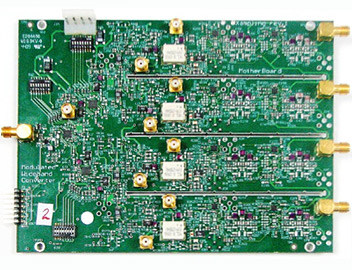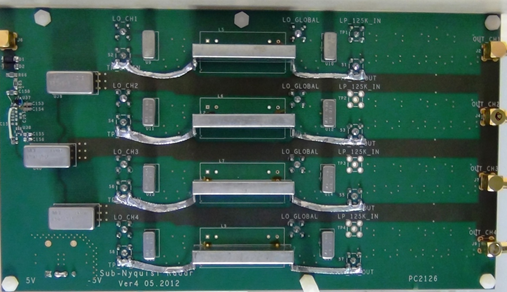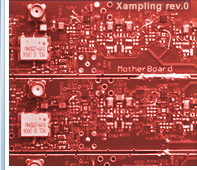 |
Signal Acquisition and Processing
in Union of Subspaces
Moshe Mishali and Yonina C. Eldar What is Xampling ?
Xampling is a system architecture designed for sampling and processing of analog inputs at rates far below the Nyquist rate, whose underlying structure can be modeled as a union of subspaces. This website provides a brief introduction to union modeling and the Xampling framework, through several examples of engineering applications.
More detailed information on Xampling can be found on our Xampling workshop page and in the tutorial slides below.
You can learn more about Xampling by viewing several tutorials presented at the Xampling Workshop at the Technion, You can also see some Xampling Demos on our hardware page. A short video which demonstrates sub-Nyquist sampling and processing for ultrasound imaging can be found here, and a demonstration of sub-Nyquist radar can be found here. Finally, the links under the Xampling tab to the left contain more information on specific applications.
Motivation
Consider a communication receiver which intercepts multiple radio-frequency (RF) transmissions, but is not provided with their carrier frequencies fi. In this setting, the input x(t) has multiband spectra with energy that concentrates on N frequency intervals of individual widths B located anywhere below some maximal frequency fmax. Such a receiver faces a challenging sampling problem, since classic acquisition methods, such as RF demodulation or bandpass undersampling, require knowledge of the values fi. At first sight, it may seem that sampling at the Nyquist rate, namely twice fmax is necessary, since every frequency interval below fmax can potentially contain a transmission of interest. On the other hand, since each specific x(t) fills only a portion of the Nyquist range (only NB Hz), one would intuitively expect to be able to reduce the sampling rate below 2fmax.

Another interesting application is estimation of time delays of an input signal that consists of several echoes of a given pulse shape. This scenario is encountered, for example, in a communication channel that introduces multipath fading. Another example is radar, where the delays correspond to target locations, while the attenuations of each pulse encode Doppler shifts indicating target speeds. Medical imaging techniques, e.g. ultrasound, record signals of this form to probe density changes in human tissues as a vital tool in medical diagnosis. Underwater acoustics also conform with this signal model. Since in all these applications, the pulse shape is short in time, sampling according to its Nyquist bandwidth results in unnecessary large sampling rates. In contrast, it follows intuitively that the actual number of unknowns is 2L where L is the number of echoes, which in all the above applications can be substantially lower than the Nyquist rate.

Union of Subspaces
The model of union of subspaces is illustrated in the
following figure. The input signal x(t) lies in either of the subspaces A_lambda. However,
apriori, the exact signal subspace is unknown. This is
different from traditional models studied in classic
sampling theory, which assume that the input lies in a
predefined subspace. Bandlimited signals are perhaps the
most prevalent example of classic modeling.
Mathematically, the union is
formulated with the following equations:


A union model can readily capture the motiving
applications of multiband communication or time-delay
echoes, as we shall see in the relevant pages of this
website.
Unified Architecture
The Xampling framework we propose has the
high-level architecture presented below, which unifies
the treatment in all the example applications considered
hereafter. The first two
blocks, termed X-ADC, perform the conversion of x(t) to digital. An operator P compresses the high-bandwidth input x(t) into a signal with lower bandwidth, effectively
capturing the entire union U by a subspace S with substantially lower sampling requirements. A
commercial ADC device then takes pointwise samples of
the compressed signal, resulting in the sequence of
samples y[n].
The role of P in Xampling is to narrow down the analog bandwidth that
proceeds acquisition, so that lowrate ADC devices can
be used. As in digital compression, the goal is to
capture all vital information of the input in the
compressed version, though here this functionality is
achieved by hardware rather than software. The design of P therefore needs to wisely exploit the
union structure, in order not to lose any essential
information while reducing the bandwidth.
Two example prototype boards that are currently used in cognitive radio and radar are shown below:


In the digital domain, Xampling consists of three
computational blocks. A nonlinear step detects the
signal subspace from the lowrate samples. Once the index
lambda^* is determined, we gain backward compatibility,
meaning that standard DSP methods apply and commercial
DAC devices can be used for signal reconstruction. The
combination of nonlinear detection and standard DSP is
referred to as X-DSP. As we shall demonstrate, besides
backward compatibility, the nonlinear detection
decreases computational loads, since the subsequent DSP
and DAC stages need to treat only that subspace. The
important point is that the detection stage can be
performed efficiently from the lowrate samples.

What can be found on this website?
Xampling enables sampling and processing at rates
lower than Nyquist. We describe several sampling systems for interesting union models
in the following pages:
A tutorial on Xampling can be found:
Reference
- M. Mishali and Y. C. Eldar, "Xampling: Compressed Sensing for Analog Signals", Compressed Sensing: Theory and Applications, Edited by Y. C. Eldar and G. Kutyniok, Cambridge University Press, 2012.
- M. Mishali and Y. C. Eldar, "Sub-Nyquist Sampling: Bridging Theory and Practice", IEEE Signal Processing Magazine, vol. 28, no. 6, pp. 98-124, Nov. 2011.
- M. Mishali, Y. C. Eldar and A. Elron, "Xampling:Signal Acquisition and Processing in Union of Subspaces",
IEEE Transactions on Signal Processing, vol.59, issue 10, pp.4719-4734, Oct. 2011.
|
|
 |
Copyright © 2010 Professor Yonina Eldar. All Rights Reserved. |
|

